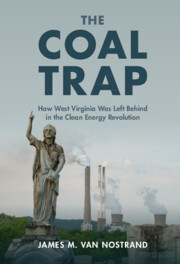Book contents
- The Coal Trap
- The Coal Trap
- Copyright page
- Dedication
- Contents
- Figures and Tables
- Introduction: “The Lost Decade”
- 1 The Rise of Environmental Regulations under Obama’s Environmental Protection Agency
- 2 The Shale Gas Revolution
- 3 The Rise of Renewable Energy
- 4 The “Ds” of Today’s Electric Utility Industry: Decarbonization and Decentralization
- 5 From “Friends of Coal” to the “War on Coal”: How West Virginia Went from Blue to Red
- 6 “Leadership” from Washington, DC: The Congressional Delegation That Could Have but Didn’t
- 7 Manchin in the Middle
- 8 The Failure of the Public Service Commission to Serve the Public
- 9 The Role of the Legislature in West Virginia’s Failed Energy Policies
- 10 Bailing Out the Coal Industry on the Backs of West Virginia’s Electric Ratepayers
- 11 Coal Operators Get Rich and West Virginia Gets to Clean Up the Mess
- 12 What the Future Could Hold if Leaders Choose to Lead
- Acknowledgments
- Index
3 - The Rise of Renewable Energy
Published online by Cambridge University Press: 07 July 2022
- The Coal Trap
- The Coal Trap
- Copyright page
- Dedication
- Contents
- Figures and Tables
- Introduction: “The Lost Decade”
- 1 The Rise of Environmental Regulations under Obama’s Environmental Protection Agency
- 2 The Shale Gas Revolution
- 3 The Rise of Renewable Energy
- 4 The “Ds” of Today’s Electric Utility Industry: Decarbonization and Decentralization
- 5 From “Friends of Coal” to the “War on Coal”: How West Virginia Went from Blue to Red
- 6 “Leadership” from Washington, DC: The Congressional Delegation That Could Have but Didn’t
- 7 Manchin in the Middle
- 8 The Failure of the Public Service Commission to Serve the Public
- 9 The Role of the Legislature in West Virginia’s Failed Energy Policies
- 10 Bailing Out the Coal Industry on the Backs of West Virginia’s Electric Ratepayers
- 11 Coal Operators Get Rich and West Virginia Gets to Clean Up the Mess
- 12 What the Future Could Hold if Leaders Choose to Lead
- Acknowledgments
- Index
Summary
While the impact of the shale gas revolution was the biggest driver of the decline of the coal industry in West Virginia, the increasing cost competitiveness of renewable generating sources – primarily solar photovoltaic (PV) and wind – also played a role, albeit a much smaller one, in West Virginia than on the national stage. The April 2017 study by the Columbia Center on Global Energy Policy1 found that growth in renewable energy across the United States was responsible for about 18 percent of the decline in domestic coal production between 2011 and 2017, a distant third to the role of natural gas (49 percent) and lower than expected demand for electricity (26 percent).
- Type
- Chapter
- Information
- The Coal TrapHow West Virginia Was Left Behind in the Clean Energy Revolution, pp. 63 - 75Publisher: Cambridge University PressPrint publication year: 2022

